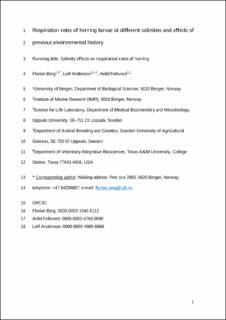| dc.contributor.author | Berg, Florian | |
| dc.contributor.author | Andersson, Leif | |
| dc.contributor.author | Folkvord, Arild | |
| dc.date.accessioned | 2021-01-14T10:24:30Z | |
| dc.date.available | 2021-01-14T10:24:30Z | |
| dc.date.created | 2020-04-14T12:25:35Z | |
| dc.date.issued | 2020 | |
| dc.identifier.citation | Marine Ecology Progress Series. 2020, 650 141-152. | |
| dc.identifier.issn | 0171-8630 | |
| dc.identifier.uri | https://hdl.handle.net/11250/2722971 | |
| dc.description.abstract | Metabolic rates of early life history stages of marine fishes show considerable inter-individual differences and are highly influenced by extrinsic factors like temperature or food availability. Measuring oxygen uptake rates is a proxy for estimating metabolic rates. Still, the relationship between respiration rates and ambient or previous salinity conditions as well as parental and developmental acclimation to changes in salinity is largely unexplored. In the present study, we conducted experiments to investigate salinity effects on the routine metabolic rates (RMR) of euryhaline Atlantic herring (Clupea harengus) larvae at three levels of salinity: low (6 psu), intermediate (16 psu) and high (35 psu) reflecting ecological relevant conditions for its populations in the Atlantic and Baltic Sea. The larvae originated from different genetic backgrounds and salinity adaptations to account for cross-generation effects on metabolic rates. Closed respirometry carried out over 24 h on individual fish larvae generally confirmed near isometric respiration rates at all salinity regimes, with rates being 15.4% higher at 6 psu and 7.5% higher at 35 psu compared to 16 psu conditions. However, transgenerational acclimation to different salinity regimes of parents had no effect on the salinity specific metabolic rates of their offspring. Our study demonstrates the ability of herring to cope with a wide range of salinity conditions, irrespective of parental environmental history and genetic origin. This phenotypic plasticity is considered to be one of the main contributing factors to the success of herring as a widely distributed fish species in the North Atlantic and adjacent waters. | |
| dc.language.iso | eng | |
| dc.title | Respiration rates of herring larvae at different salinities and effects of previous environmental history | |
| dc.type | Peer reviewed | |
| dc.type | Journal article | |
| dc.description.version | acceptedVersion | |
| dc.source.pagenumber | 141-152 | |
| dc.source.volume | 650 | |
| dc.source.journal | Marine Ecology Progress Series | |
| dc.identifier.doi | 10.3354/meps13318 | |
| dc.identifier.cristin | 1806090 | |
| dc.relation.project | Norges forskningsråd: 254774 | |
| cristin.ispublished | true | |
| cristin.fulltext | postprint | |
| cristin.qualitycode | 2 | |
